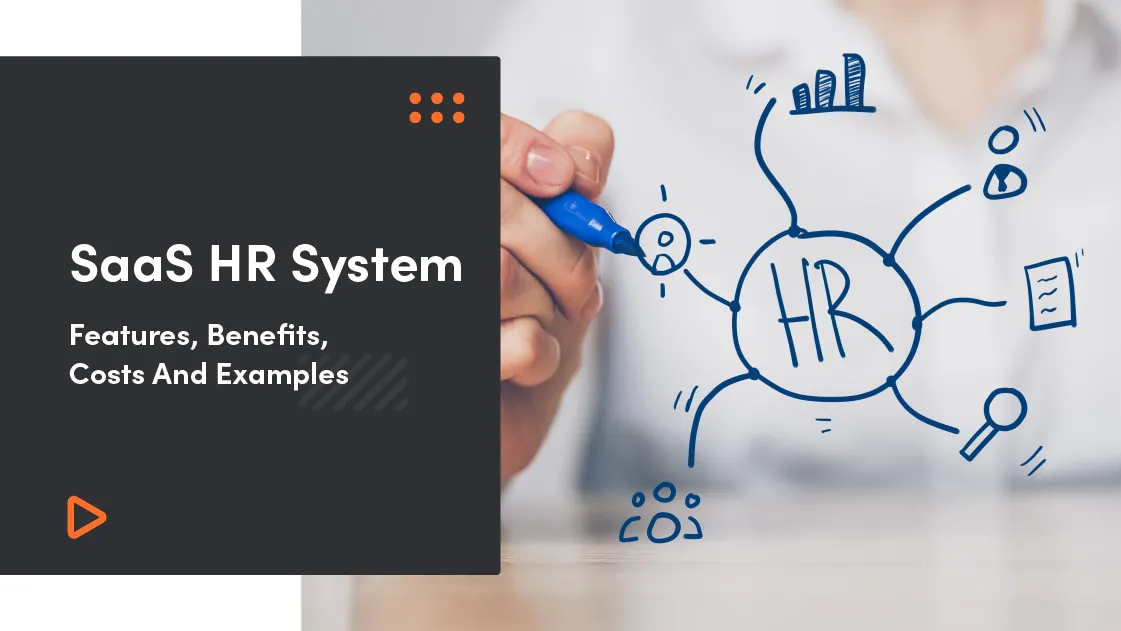Back in the 90's Human Resource operations were limited to hiring labour, paying salaries, and managing other perks. Currently in 2023, HR technology trends emphasized the optimization of existing systems, support for hybrid work, and the expansion of artificial intelligence solutions applications. HR leaders were encouraged to make the most of their current technology stacks before considering new investments. This approach was particularly relevant in times of economic uncertainty, focusing on process optimization and integration of existing tools to enhance efficiency and the employee experience.
Employee engagement was recognized as a critical factor for business success, with companies focusing on this area seeing potential profitability increases. The statistics highlighted a significant link between employee engagement efforts and overall business performance.
Regarding HR technology, it was reported that 36% of HR professionals felt they lacked the necessary technology to simplify their tasks. The use of the right HR system was associated with up to a 15% improvement in retention rates, underscoring the importance of technological tools in supporting HR functions and contributing to a positive company culture
What will you learn from this article:
- What are the benefits of using HR Software in Human Capital Management?
- How to Calculate the ROI of an HR Solution?
- What are must-have features for SaaS HR software?
- How SaaS HR system should be integrated with other operational platforms used in business HR tasks?
- Example of Top 5 SaaS HR Solutions.
What is SaaS HR Software?
SaaS HR software provides business owners with the ability to control every aspect of their employee management tasks online. With this system, HR departments can eliminate human-errors and mundane tasks such as wrangling multiple spreadsheets and managing time cards for employees’ attendance. It also helps to prevent paper personnel records from bursting out of overloaded filing cabinets.
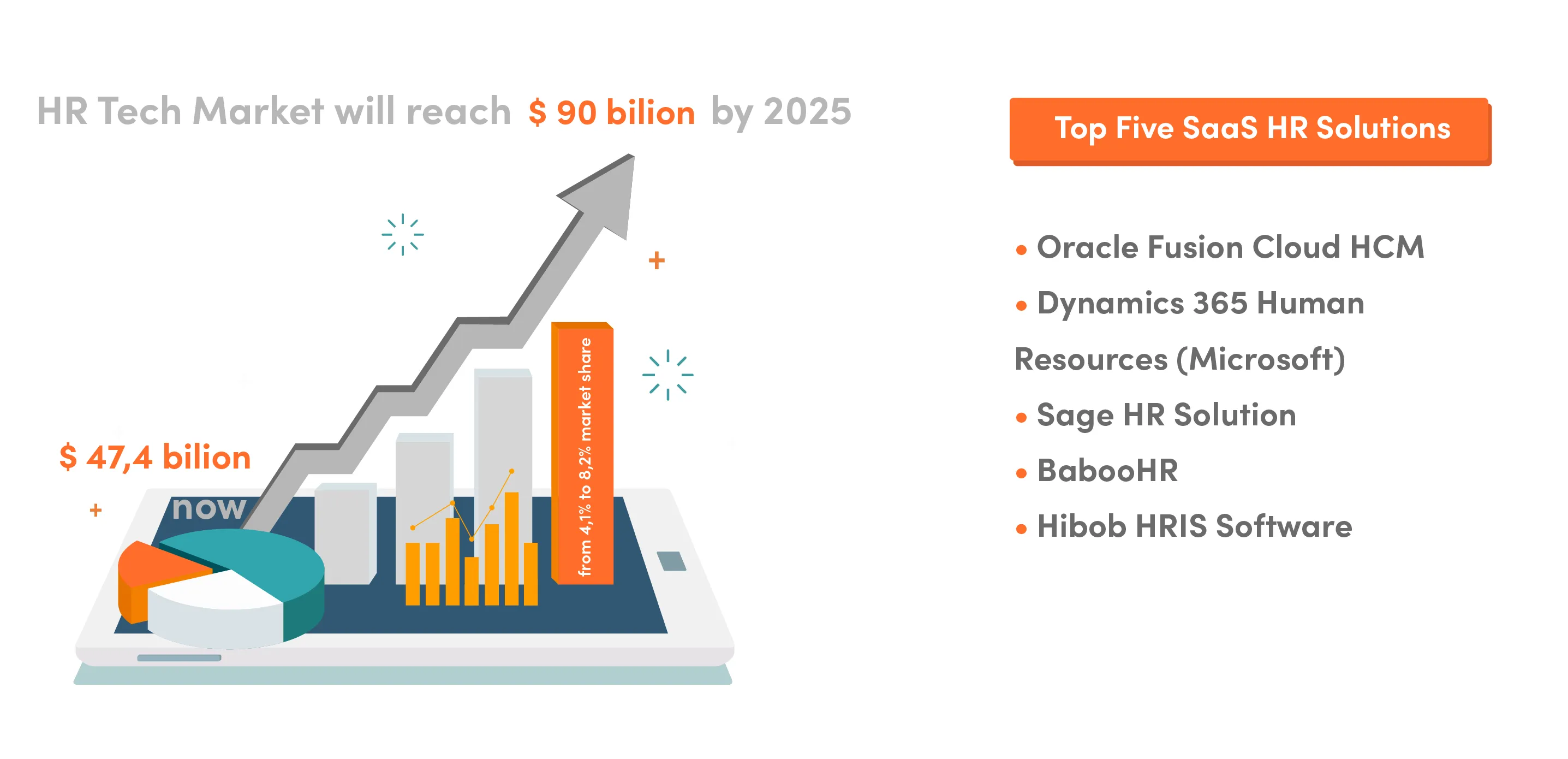
The Benefits of HR SaaS Solutions in HR Processes
A SaaS-based HR solution gives businesses the computing power and the ability to survive and thrive in the information era without following the old school HR approaches.
Let’s discuss some of the greatest benefits of HR Software that business owners avail by implementing it in their organization.
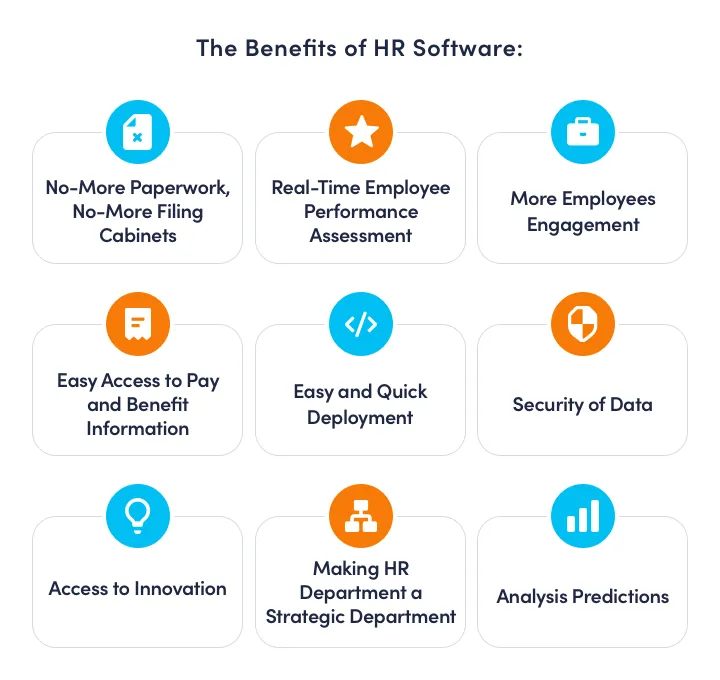
Benefit #1: No-More Paperwork, No-More Filing Cabinets
After the evolution of cloud-based HR software (software as a service), there is no need for storing employee records in large file cabinets. With a cloud-based HR system, HR can store all employees’ information securely in apps like Box, Google Drive and Dropbox. It takes only seconds for an HR manager or HR executive to locate any employee’s detail among millions of records and print it on paper.
Krystal H., an HR manager of a company with 201-500 Employees, explained how the HR software helped cut their paperwork by half:
ADP Workforce Now is great for large or small businesses. We can keep up with time cards very easily through the app and the online system. With over 300 employees, ADP has cut down paperwork for the HR/Payroll department by half. Most of the information employees need available in one of the many sections of ADP. It also made open enrollment paperless and much easier to track.
Benefit #2: Real-Time Employee Performance Assessment
Employee performance assessment is a critical job of an HR manager. Previously, businesses conduct yearly performance reviews. Now the scenario has changed completely; the performance assessment starts with the first day of the job and keeps going as long as the employee is on pay-scale. Having such kind of assessment requires a lot of paperwork in the ’90s, but with HR saas software, employee performance is tracked automatically in real-time. Gathering data and analyzing it becomes very easy with built-in dashboards, reports, and machine learning. Cloud HR solutions help the HR team put the right new systems in place or provide additional training in just a matter of hours.
Benefit #3: More Employees Engagement
With many new functionalities in the HR job description, creating employee engagement is one of the tasks. Employee engagement is a competitive source of advantage for businesses. It brings high customer satisfaction levels, knowledge sharing, business agility, bottom-line profitability, and interest from new applicants. If used correctly, HR software can help humanize the workplace and improve long-term relationships.
Benefit #4: Easy Access to Pay and Benefit Information
With SaaS-based HR software, employees can access information about their pay and benefits anytime, anywhere. They can check how much of their salary goes to taxes, 401(k), and more.
Employees can also make changes in their pay and benefit settings. An employee using a cloud HR system can set up direct deposit, change their health insurance, and more without requesting it from an HR professional.
Benefit #5: Easy and Quick Deployment
Cloud-based HR solution is easy to deploy and can be done very quickly. It is easy to deploy compared to standalone or legacy HR systems. SaaS providers will handle all the security and system update tasks.
Benefit #6: Light on Pocket
Businesses spend so much money on hiring HR personnel or deploying proprietary HR management software. In contrast, a cloud-based HR system is a much cheaper option and provides more value for lower upfront costs. Once deployed, a cloud-based HR system starts producing returns such as better data and time savings and bring more employee satisfaction.
Benefit #7: Security of Data
Cloud HR services take the security of your business data very seriously. They implement all the latest mechanisms to safeguard your company’s sensitive data. As a result, security is on them, not you, to maintain, even as regulations change.
Benefit #8: Access to Innovation
Through cloud-based HR solutions, small companies get easy access to innovation, which gives them a competitive advantage to compete with big corporations by keeping themselves a step ahead in technology trends. Adapting to changes and adopting new solutions as they move forward.
Benefit #9: Making HR Department a Strategic Department
Thanks to cloud computing, now HR departments are at the forefront of improving employee engagement and developing winning workplace cultures. Data is centralized and more accessible with instant reporting and analysis of trends and information is quicker. With these tools, HR can effectively lead the way in making better decisions to improve employee recruitment, retention, and performance.
Benefit #10: Analysis Predictions
A cloud-based HR software can some extent detect and remedy employee issues before they lead to someone quitting or losing productivity. The feature is still emerging, but experts explain why it’s so exciting and predict it will be key to HR’s strategic role in keeping businesses competitive:
Eva Winslow explains:
As much as it is difficult to hire talented employees, it is as difficult to keep them in your team. This is why almost 60% of organizations consider employee retention their biggest problem. However, AI has the ability to analyze and predict the needs of staff members.
Try our developers.
Free for 2 weeks.
No risk. Just results. Get a feel for our process, speed, and quality — work with our developers for a trial sprint and see why global companies choose Selleo.
What are the Key Features of a SaaS HR Solution?
A SaaS HR solution is meant to deal with every function of an HR department. Keeping this in mind, here’re the must-have features for SaaS HR software.
1. Application Tracking and Recruiting
HR software solutions should be able to first and foremost conduct the following operations:
- Design email templates to take the hassle out of communicating with job applicants.
- Scheduling interviews with an integrated system connected to the company’s email. As the interview is scheduled, both the applicant and the interviewing department will receive an email with the date and time.
- An automated option to post jobs, collect resumes, and screen them for interviews.
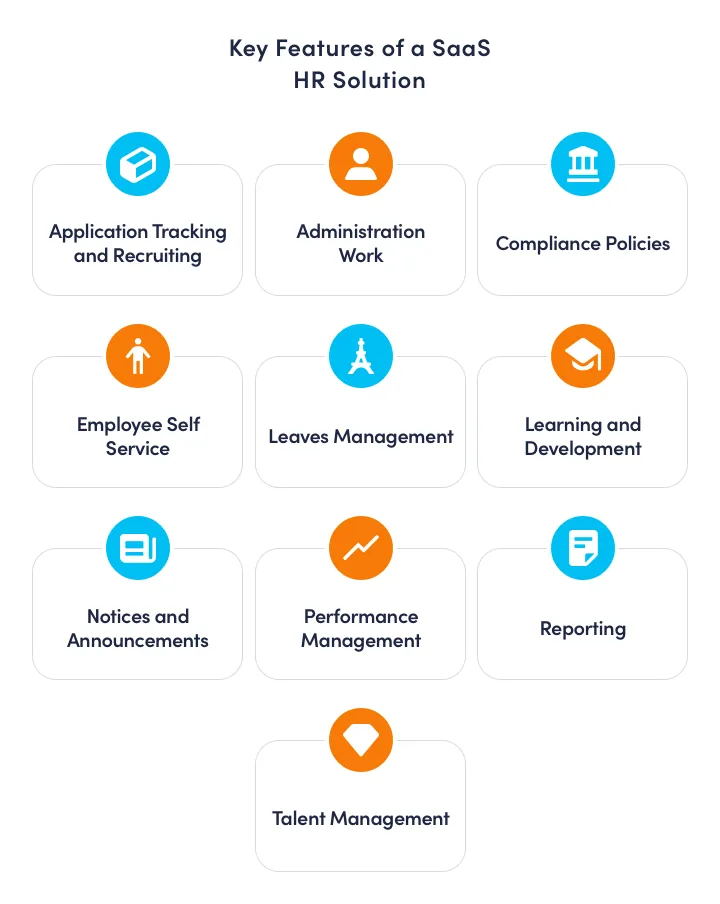
2. Administration Work
As mentioned earlier, with a SaaS HR solution, there is no need for paperwork. All employees’ salary calculations, deductions, and perks allocations will be made automatically in the payroll system without any manual data entries. Employees can also enter their information and make changes if needed without involving HR.
3. Compliance Policies
Laws and regulations change very rapidly. Keeping every employee aware of these laws and regulations and creating guidelines in a workplace compliant with these laws is a heck of a job. A great HR SaaS solution will manage all of your business compliance concerns.
Here’s how a solution can help:
- Align policies with tax obligations (especially across multiple states or jurisdictions),
- Ensure that all stakeholders in the company are properly classified,
- Making sure policies are compliant with all appropriate local, state, and federal laws.
4. Employee Self Service
Employee self-service (ESS) is a great administrative feature that helps lessen the burden of HR personals. With ESS's help, employees can input their own information, change or update it when needed without the involvement of any HR person.
5. Leaves Management
By using ESS options, employees can apply for leaves, check the status of their remaining leaves, and approve or disapprove of their application. A leaves management module in your human resource management system will help manage highly complicated leave of absence rules and time calculations.
6. Learning and Development
Rather than arranging traditional classes and taking hours out of employees from their day-to-day operations, HR can arrange online training sessions for employees by using a cloud-based HR solution. This feature can also help train new employees and interns.
7. Notices and Announcements
I-9, W-4, 1099-C, direct deposit - all of these forms can be automated and tied directly to the payroll system is an incredible time, and employees can fill them in their own time. Similarly, using the same system, HR can send notices and make announcements without going door to door in each department or pasting banners on the notice board.
8. Performance Management
If you ask the employee to sit in front of the manager and the department head and justify the work he/she did a year ago, that will make him/her hate the review process. By using HR software, the process becomes effortless, and the evaluation will be done in real-time based on set KPIs and targets, making the process more engaging for employees.
9. Reporting
Having all the data of employees but not knowing what to do with it can make it useless. A great SaaS HR solution provides you with a reporting dashboard where an HR manager can see turnover, headcount, overtime, time and attendance, benefits, and more to help the HR team create strategic plans and solve problems if any.
10. Talent Management
The employee is not an expense; they are the greatest assets for any business. A talent management system can help you easily look at all your job roles and who’s in them to determine where you might have gaps. It keeps your retention rate low, monitors tenure, how long it takes to fill a vacant position and calculates the revenues full-time employees generate.
What are the Key Challenges of a SaaS HR System?
Like any other platform, SaaS HR also has 4 key factors that can be really challenging for developers, and if done right, can be the cause of success for the software. These four key factors are as follows:
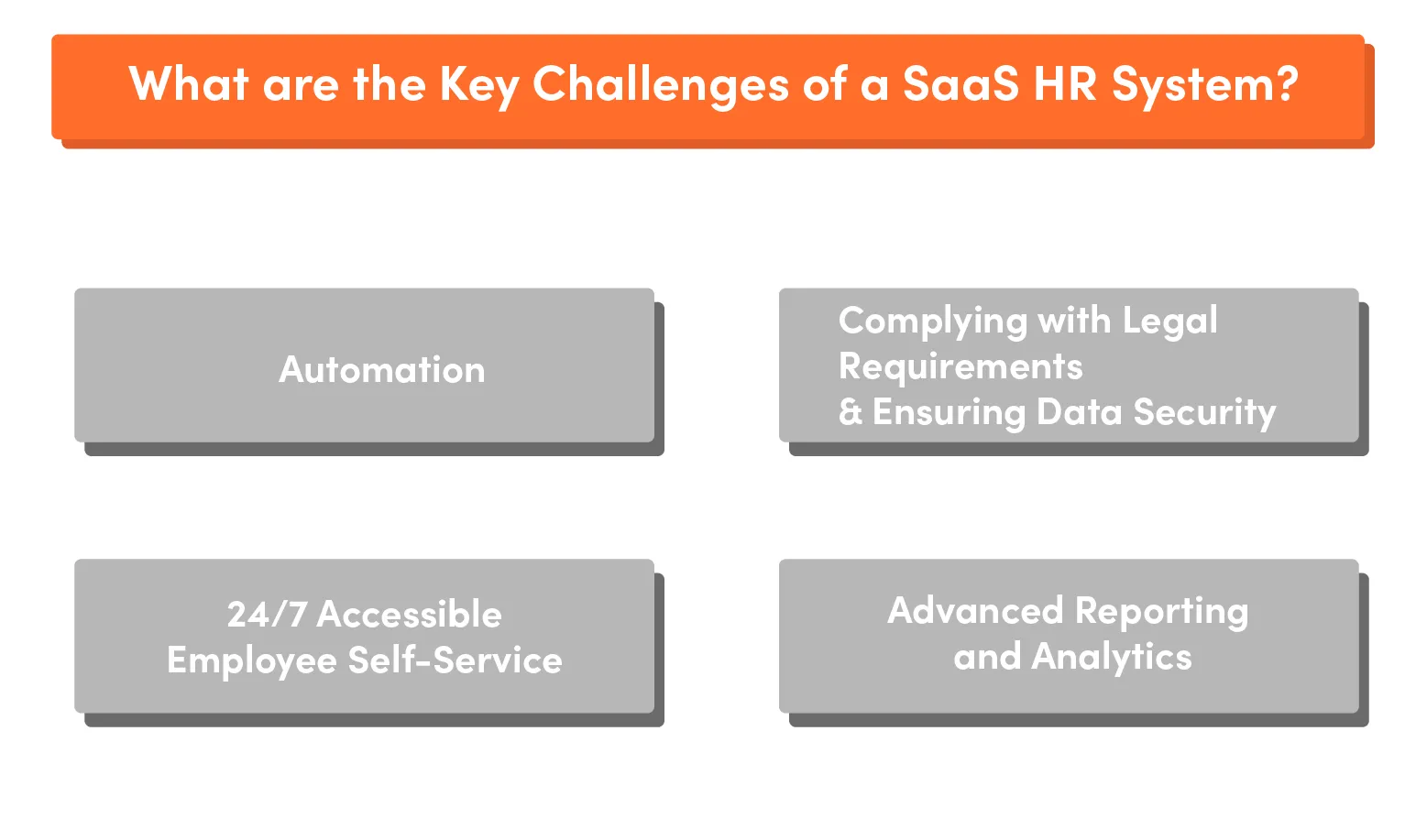
Automation
A SaaS HR solution is meant to make the HR team's life lot easier using a high level of automation from the onboarding process to payroll and expense reporting.
Complying with Legal Requirements & Ensuring Data Security
One of the biggest hurdles or you can say the most damaging business point when they failed to meet the compliance policies or failed to protect employees’ personal data.
Irrespective of the size of a business, federal laws, and local regulations are implied on all. It is crucial for a SaaS HR system to keep the business operation complying with laws and regulations and for SaaS providers to enhance data security at all endpoints.
Advanced Reporting and Analytics
To make all the data useful, an HR solution should be designed to provide advanced reporting and analytics based on employee skills, performance, and other factors.
24/7 Accessible Employee Self-Service
Accessibility on a 24/7 basis is one of the key advantages of having a SaaS HR system. A great SaaS HR system provides accessibility to employees to view absence history, apply for a leave or request overtime payment without seeking assistance from the HR team, anytime, anywhere.
How to Calculate the ROI of your HR Solution?
It is highly recommended to measure the ROI of your HR solution. Either the software worth your money? Either it is providing the expected financial benefits or not? All these questions should be answered.

Here’s how you can measure the ROI of your HR solution:
- Step 1. Determine the implementing cost and the ongoing charges for the HR system. (Be sure to take all of these potential expenses into account when calculating the HR software cost.).
- Step 2. Determine both tangible and non-tangible benefits you are reaping from the software. Tangible Benefits include greater productivity, reduced employee turnover, and better business processes. And, intangible benefits include reduced stress levels and improved company culture.
- Step 3. Now accumulate the cost in one place and all benefits, on the other hand. Just take the total estimated revenue produced by your solution and divide it by the cost of using it. The resulting number is your ROI.
Top Five SaaS HR Solutions
Here are examples of the best SaaS HR solutions in the industry.
Oracle Fusion Cloud HCM
Oracle Fusion Cloud HCM is best suited for mid-sized and large organizations. It provides all functionality from hiring to retirement, talent management, payroll and workforce management, and global HR.
Key Features of Oracle Fusion Cloud HCM:
- HRM,
- Workforce modelling/Workforce planning,
- Talent acquisition and reviews,
- Career development monitoring,
- Payroll management,
- Time tracking,
- Business intelligence,
- HR help desk,
- Performance management,
- Compensation/benefits management,
- Data visualization,
- Expense management.
Dynamics 365 Human Resources (Microsoft)
Dynamic 365 HR Solution is another name in the industry that is well-known for its functionality. It can be easily integrated with Microsoft tools to give more benefits. It will cost you around $120 per user/ month.
Key Features of Dynamic 365 Human Resources (Microsoft):
- Employee self-service,
- Performance review templates,
- Skills gap analysis.
Sage HR Solution
Sage HR Solution is a cloud-based HRM solution that offers core features such as 360 feedback, workforce management, performance appraisal, and attendance tracking. It also offers Android and iOS apps and a separate login area for each employee to do repetitive tasks and save HR time.
Key Features of Sage SaaS HR Software Solutions:
- Easy to use and deploy,
- Lots of good features,
- Attractive and easy-to-understand graphical reports.
BabooHR
BambooHR is a cloud-based HRM for small and growing businesses. It offers an HR department the ability to improve the hiring process, onboard new employees, manage compensation, maintain and analyze employee data, and develop company culture.
Key Features of BambooHR:
- Human Resource Information System (HRIS) with applicant tracking system (ATS),
- Time Tracking,
- Payroll processing,
- Benefits administration,
- Employee engagement and employee satisfaction tools,
- Automated reminders.
Hibob HRIS Software
Hibob HRIS Software it is an HRM designed to improve the employee experience and lifecycle for companies with 50+ employees. It helps businesses simplify onboarding, attendance, and performance reviews while giving decision-makers actionable insights using data-driven resources and engagement tools.
Key Features of Hibob HRIS software:
- It’s dynamic and catchy UI,
- Software is efficient, effective, and an all-around,
- Easy-to-use.
When should you choose Custom HR Software?
If you need highly user-friendly and easy-to-use HR software, then Custom HR Solution is the best choice. When you have a unique HR workflow, or you want the basic functionalities of an HR solution for your business, then go with Custom HR software.
Another important reason for choosing a custom HR solution is when your business model is subject to regulations that have not been accommodated by ready-made HR software. Custom systems have their advantages and disadvantages, let's look at them.
Advantages:
- 100% build on your business requirements,
- High security, as only you and your team will have access to the code,
- Complete and integrated, as opposed to canned solutions that tend to automate the bits and pieces or do one thing well and the other.
Disadvantages:
- A huge amount of upfront investment to build a custom HR solution.
Recommendation Integration for SaaS HR Solutions
SaaS HR system should be integrated with other operational platforms used in business tasks such as:
- ERP Integration: A seamless connection with your Enterprise Resource Planning (ERP) system offers a comprehensive view of your business's functionality and productivity. This integration facilitates data consistency across departments, enhancing decision-making processes. For example, SAP SuccessFactors and Oracle ERP Cloud have demonstrated robust interoperability, streamlining HR and financial data flow.
- Document Management System (DMS): Integrating your HR system with a DMS like SharePoint or Google Drive can significantly streamline employee document management processes. This ensures secure and efficient access to employee records, contracts, and compliance documents, reducing manual errors and saving time.
- Help Desk Tool: A Help Desk integration, such as with Zendesk or ServiceNow, enables efficient processing of employee requests, from IT support to HR inquiries. This not only improves response times but also enhances employee experience by providing a single point of contact for assistance.
- Learning Management System (LMS): Syncing your HR system with an LMS like Moodle or Cornerstone allows for the automatic update of employee competencies and training records. It ensures that talent development is closely aligned with business needs and employee career paths. Case studies from companies like Zappos have shown how effective LMS integration can foster a culture of continuous learning and improvement.
- Employee Chatbot: Implementing an employee chatbot, such as Slack's Workflow Builder or Microsoft's Power Virtual Agents, streamlines onboarding, training, and FAQs. Chatbots provide immediate, round-the-clock support to employees, enhancing their engagement and satisfaction.
Implementation Insights:
- Start Small: Begin with the integration that addresses your most immediate need. This approach allows for focused implementation and troubleshooting.
- Choose Compatible Systems: Ensure the platforms you're integrating have compatible APIs or offer integration support. Consultation with IT specialists can provide valuable insights into this aspect.
- Plan for Scalability: Consider how these integrations will scale with your business. Scalability ensures that as your company grows, your systems can adapt without requiring a complete overhaul.
- Security and Compliance: Always prioritise security and compliance, especially when integrating systems that handle sensitive employee data. Regular audits and adherence to data protection standards are essential.
Conclusion
Building a custom SaaS-based HR solution is not an easy job. If you want guidance regarding your business model, whether you should go for a custom build HR solution or not, or if you want an expert development team to design a perfect cloud-based HR solution for your company, you can always contact Selleo.
